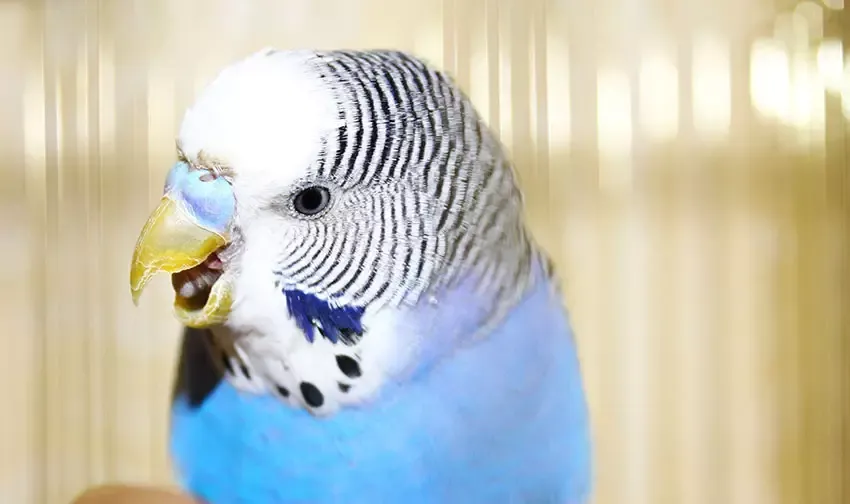Parakeets, also known as budgerigars or budgies, have an incredible ability to mimic human speech, making “How To Get Your Parakeet To Talk” one of the most exciting challenges for bird owners. Male parakeets are typically the best talkers, as they naturally respond to human voices during their development. To succeed, start by ensuring your bird is finger-trained and comfortable around you—this builds trust and makes him eager to listen. For more bird training inspiration, check out how to get your parrot to talk.
Higher-pitched voices, like those of women and children, often appeal more to parakeets than deeper male tones. If you’re teaching solo as a man, experiment with your highest register to mimic that appealing sound. Observing your parakeet’s mood is key; a content bird perched and chattering softly is primed for lessons.
 woman with parakeet
woman with parakeet
Essential Tips for Teaching Parakeets to Talk
Before diving into formal training, ensure your parakeet feels secure in his environment. Even from day one at home, surround him with gentle human conversation to familiarize him with speech patterns. Look for signs of receptivity: a slightly fluffed-up posture with lively self-chatter indicates he’s relaxed and attentive.
Optimal times for sessions are mornings, when he’s fresh, or evenings after feeding, as he winds down with natural vocalizations. Position your face near the cage and repeat target words slowly and clearly—watch for his eyes dilating, a positive sign of engagement. Begin with his name: “Hello, Kiwi!” or “Kiwi’s a good boy!” Use real phrases tied to his name for better retention.
Limit sessions to 10-15 minutes, twice daily, minimizing distractions like TV or loud noises. Mix in casual chats, returning to core phrases with enthusiasm—lively intonation captures their interest far better than monotones. Avoid shouting, as it startles them.
Throughout the day, narrate interactions: “Good morning!” at dawn, “Where’s your food?” while refilling seeds, or “Good boy!” when he steps on your finger. This associates words with routines, accelerating learning. When he mimics, echo back immediately to reinforce.
Progress gradually; master one word before adding another. Offer a small treat like millet spray for initial successes, but taper off to prevent treat-dependent talking, which can lead to frustrated squawks. Patience is vital—never show frustration, as negative vibes halt progress.
Veterinarians and avian experts, such as those from the Association of Avian Veterinarians, emphasize consistent, positive reinforcement for vocal training. Real-life owners report success after weeks of daily practice, turning quiet birds into chatty companions.
Advanced Techniques for Parakeet Talking Mastery
For dedicated owners, elevate training by linking words to objects, actions, and emotions, leveraging the parakeet’s innate intelligence. Name daily items: “toy,” “perch,” or “seeds” as he interacts with them. Introduce visitors with “This is Mom!” and comment on surroundings to build contextual vocabulary.
Play upbeat songs and sing along—mimicry-prone birds often pick up tunes. Focus on emotional expression to deepen communication:
- Affection: During preening or relaxed perching, say “Kiwi’s beautiful!” in a warm tone, especially if he’s affectionate toward you.
- Anger: For tantrums with puffed feathers, note “Kiwi’s angry!” sharply but calmly—advanced birds may reuse it independently.
 parakeet talking
parakeet talking
- Pleasure: When beak-grinding or softly twittering, affirm “Kiwi’s happy!” or praise his “lovely song.” This ties phrases to contentment.
- Fear: Spot rapid breathing, flapping, or frozen postures? Gently say “Kiwi’s scared!” It helps him alert you verbally later.
- Grief or Illness: Rare, but for listlessness after loss or sickness, use “Kiwi’s sad!”—though prioritize vet visits for health issues over training.
 parakeet anger
parakeet anger
Not all parakeets become super-talkers; many blend words into unique gibberish. True conversationalists are rare gems, capable of expressing needs. Experienced breeders note that hand-raised males under one year learn fastest, aligning with studies on avian cognition.
Final Thoughts on Parakeet Speech Training
Mastering how to get your parakeet to talk requires consistency, positivity, and attunement to his world—from basic hellos to emotional insights. Celebrate small victories, like his first garbled “hello,” and consult avian vets for tailored advice, especially if mood changes signal health concerns.
With time, your bond deepens through shared language. Explore more pet care tips on our site for holistic bird wellness.
References:
- Omlet Bird Guides: Parakeet Taming and Training (omlet.us)
- Association of Avian Veterinarians: Behavioral Enrichment Guidelines
